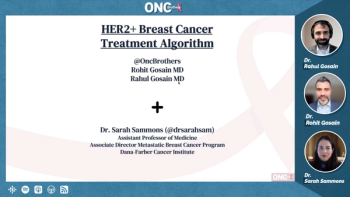
Patrick I. Borgen, MD, on What We Can Look Forward to in Breast Cancer Treatment
The breast cancer expert, in an interview with CancerNetwork®, discussed advances in the field of breast cancer and what we can expect to see in the pipeline moving forward.
Patrick I. Borgen, MD, chair of surgery and director of the breast cancer program at Maimonides Medical Center, spoke with CancerNetwork® about what we can look forward to in the breast cancer space and how the field continues to evolve.
CancerNetwork®: Is there anything new in genetic testing or new problems that we look to solve in this space?
Borgen: So, our understanding of the fundamentals of the genetics of breast cancer continues to evolve. What we though we understood 10, 15 years ago was really an oversimplification of a very complex problem. And so, we’re in a period of time now where we’re looking at not only the genes that play a role in breast cancer development, but we’re looking at those genes as targets for therapy. We’re looking at epigenetic factors. What really effects, do all women with the BRCA mutation have the same risk, and the answer is no. So, I think this is a very exciting time in the genetics of breast cancer.
In regard to HER2, how have we individualized therapy for early stage HER2-positive breast cancer?
Twenty-five percent of all women with invasive breast cancer, even ductal or lobular, are found to have an amplification or an abnormality in the HER2 oncogene. This has proven to be a vitally important target for therapy. In the early ‘90s, when HER2 was first discovered, we had no therapy for it and the chance of dying of a HER2-positive breast cancer was astronomically high. Today, because our therapies have been so effective, it’s completely reversed itself. In fact, in the staging system for breast cancer, having HER2 positivity now downstages the disease.
So, the big advances have been what to do in the very early breast cancers, and what to do in the later breast cancers. So, in the early space there was a trial called APT, which was a phase II trial not a phase III trial, where women with very small tumors, node negative, and HER2 positivity received a combination of chemo and trastuzumab (Herceptin), just those 2 drugs. And after 5 years, the survival was so incredibly good that that treatment, what we call TH, was adopted into therapy.
The second advance has been in the antibody drug conjugate space, where patients with T2, so larger than 2 centimeters, HER2-positive breast cancers, who received neoadjuvant therapy and do not experience a complete path response are now treated with an antibody drug conjugate called TDM1 (trastuzumab emtansine; Kadcyla). And the results have been really spectacular. So those are the 2 really exciting areas to watch right now in HER2.
Looking to the future, immunotherapy is a really trending topic in a lot of cancer types. Where do you think that we’re headed with this treatment option for breast cancer?
The immunotherapy of all solid tumors, and it certainly applies to breast cancer, we are in chapter 1 of what will be a series of volumes with hundreds and hundreds of chapters. We have a couple of targets on cytotoxic T-cells that we can go after, we know that there are many, many more targetable sites on these cells, and so this is a field that’s in its infancy. In March of 2019 atezolizumab (Tecentriq) as a PD-L1 inhibitor was approved by the FDA in metastatic, triple negative breast cancer. That was the very first approval of any true immunotherapy. We are going to see more approvals; we are going to see a broader range of patients outside of the triple negative space who will benefit from immunotherapy.
What would you say was the biggest advance in breast cancer in 2019?
Without any question, in the last calendar year, so I’m scooching it back a little into 2018, the unblinding of the TAILORx trial, showing that the intermediate group of women with invasive, ER-positive, HER2-negative, node-negative breast cancer, most of those women, did not benefit from cytotoxic chemotherapy. And so, TAILORx represented the largest single step towards avoiding overtreatment in the history of breast cancer. And then of course, in March of this year the FDA approval of atezolizumab in the metastatic, triple-negative space was a landmark news story.
Looking forward, is there anything in the breast cancer pipeline that we should be excited about in 2020?
We should be excited about everything in the breast cancer pipeline. In the antibody drug conjugate space, there are at least 6 drugs that I’m aware of in the HER2 space that are being developed. We have seen some preliminary data about oral selective estrogen receptor down regulators, SERDS. The current one we have, fulvestrant (Faslodex), is a deep intramuscular shot, which is quite painful actually. So now there are at least 2 oral SERDS out there. So, there’s so much to be excited about. Several hundred drugs nearing the end of the pipeline that all bear watching.
Newsletter
Stay up to date on recent advances in the multidisciplinary approach to cancer.




























































































